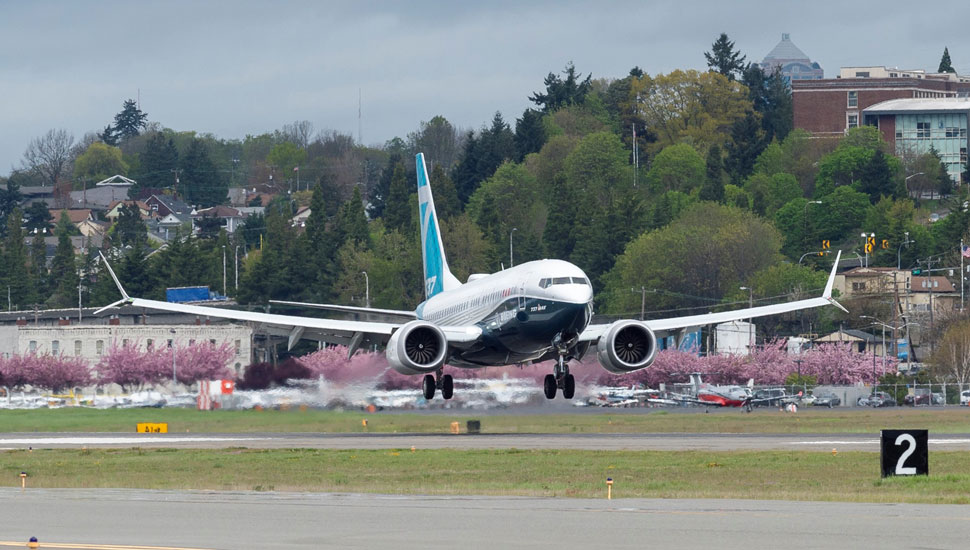Boeing’s chief executive faced an onslaught of questions on 29 April about the 737 Max and the internal processes that developed the flight control system suspected of contributing to the deaths of 346 people.
CEO Dennis Muilenburg walked a fine line when fielding questions during the company’s annual meeting in Chicago.
He defended the 737 Max’s flight control system – even as originally designed - while conceding Boeing’s responsibility to make the system “better”.
Muilenburg sidestepped questions about Boeing’s culpability and his own job security, and he eased into discussion about pilot training – a subject Boeing officials have largely not addressed.
“Understand that these airplanes are flown in the hands of pilots, and in some cases our system safety analysis includes not only the engineering design, but also the actions pilots would take as part of a failure scenario,” Muilenburg says.
He was the lone target of questions hurled by reporters and agitated investors. But Muilenburg left the meeting with his titles of CEO and board chair intact, having survived a shareholder vote on whether to split the CEO position from board chair.
In a prepared statement and in answering questions, Muilenburg returned repeatedly to several themes: Boeing’s dedication to ensure the 737 Max’s safety, the company’s history of building safe aircraft and the overall safety of air transportation. He also expressed condolences for those who died and were affected by the crashes.
“The recent accidents have only intensified our dedication” to safety,” Muilenburg tells shareholders. “When it comes to safety, there are no competing priorities. This is clear in the steps we have taken since the accidents.”

Boeing
Muilenburg dismissed suggestion that Boeing misunderstood the 737 Max’s manoeuvring characteristics augmentation system (MCAS), or that the system’s designed was fundamentally flawed.
“We have gone back and taken a look at the design of the MCAS system itself, the original design. We have confirmed that it was designed per our standards, certified per our standards and we are confident in that process,” he says. “We haven’t seen a technical slip or gap in terms of the fundamental design or certification.”
MCAS has been implicated as contributing to the October 2018 crash of a Lion Air 737 Max 8 and the March crash of an Ethiopian Airlines aircraft of the same type.
Investigators say MCAS activated on both aircraft, pushing the aircraft’s nose down due to faulty angle-of-attack (AOA) indications.
Reporters pressed Muilenburg about why Boeing developed a flight control system that could cause the aircraft to dive based on failure of a single AOA sensor.
“Can you admit that the design was flawed,” one reporter asked.
Muilenburg did not answer directly.
“We have designed the Max to have the flying qualities that were desired in the hands of the pilots,” he said. “We followed exactly the steps in our design and certification processes that consistently produce safe airplanes.”
Muilenburg then delved into the actions of the pilots at the controls of the crashed 737 Max. He cited the Max’s “runaway stabiliser checklist” – the steps Boeing says pilots should use to address erroneous activation of MCAS.
“If you go through the checklist… it calls out actions that would be taken around power management and pitch management of the airplane,” Muilenburg says. “In some cases, those procedures were not completely followed.”
American Airlines’ version of that checklist calls for pilots to cut off the aircraft’s electric stabiliser trim function and disengaging the auto-throttle, among other steps.
The Ethiopian pilots did cut off their aircraft’s trim switches, but the engines remained throttled up through most of the flight, causing the aircraft to exceed its safe allowable speed, according to the preliminary accident report. Experts have suggested high speed may have hindered the Ethiopian pilots’ ability to manually trim the stabiliser.
Muilenburg repeated stressed that Boeing has taken steps to ensure MCAS never again contributes to a 737 Max crash. Toward that end, Boeing is developing an update to the MCAS system and is set to roll out new computer-based training for pilots.
The update prevents MCAS from activating based on faulty flight data and makes the system reliant on two AOA indicators. As originally designed, one AOA sensor fed MCAS.
Boeing is working to have the Federal Aviation Administration and other regulatory bodies sign off on the update and clear the 737 Max to fly again.
“We know this is a link in both accidents that we can break,” Muilenburg says. “We are making steady progress on certification.”
Boeing has not said when the update might be certified. The grounding forced Boeing to reduce 737 production by 19% and has added about $1 billion in cost to the 737 programme.
The company has formed a committee to review procedures related to developing and certifying aircraft.
Source: Cirium Dashboard



















